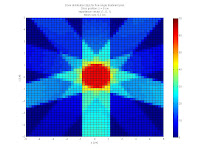 A few days ago, I handed in my last paper of the semester, a report on my development of TOLSTOY: Treatment Optimization with Linear Scoring TOY. I figure we need more codes named after famous writers (see, for example, CAFCA).
A few days ago, I handed in my last paper of the semester, a report on my development of TOLSTOY: Treatment Optimization with Linear Scoring TOY. I figure we need more codes named after famous writers (see, for example, CAFCA).
TOLSTOY’s not going to answer any pressing research questions. It’s a toy code for performing radiation therapy treatment planning calculations, a task I know laughably little about (especially considering I was once on track to become a medical physicist). But that’s kinda the point. I think to really teach the concepts involved in doing any sort of complex calculation, you have to radically simplify the task. When we’re not willing to do that, we risk spending so much curricular time laying theoretical foundations that we never help students see the forest for the trees.
I’ve always been especially bothered by this phenomenon, which David Ollis (whose work I’ve always admired) and some other folks at NC State describe here:
“Virtually all writing guides emphasize the importance of defining at the outset the direction and nature of the story to be told. Paradoxically, engineering curricula almost universally neglect this time-honored advice. Instead, most sentence the new student to math, physics, chemistry, humanities, and social sciences. Thus, one to two years pass by before any engineering courses of substance and example are offered. The student is launched upon a journey without clear definition of the voyage or description of the port of arrival. One result is found in the too-often heard remark, ‘I didn’t see what engineering was all about until my final semester, when it all came together in the design project.'”
Thankfully, engineering educators increasingly seem willing to let first- and second-year students get their hands dirty with projects that try to strike a balance between authenticity and accessibility. That’s what I was going for with TOLSTOY–a tool that a student could play with to learn something about treatment planning without having to understand every detail of radiation transport and optimization.
One of my favorite David Foster Wallace essay titles involves the CAFCA code’s namesake. The essays is called “Some Remarks on Kafka’s Funniness from Which Probably Not Enough Has Been Removed,” and I kinda feel like those last eight words should get tacked on to pretty much everything I write. But it should also serve as a guide for how we design teaching tools in the computational sciences. Without a kind of pedagogical Occam’s razor to shave away as many of the befuddling details as possible, we don’t have much hope of actually teaching anything at all.
Anyway, here’s the paper. Sorry about some of the formatting; RefWorks wasn’t kind to the citations, for some reason, and in my rush to finish my semester I didn’t catch all the errors. By the way, the image above plots the dose distribution from a five-x-ray-beam treatment plan for –ridiculously–a spherical tumor in a cubical patient with no sensitive tissues to try to spare. It’s a totally trivial example, but I thought it looked really cool.